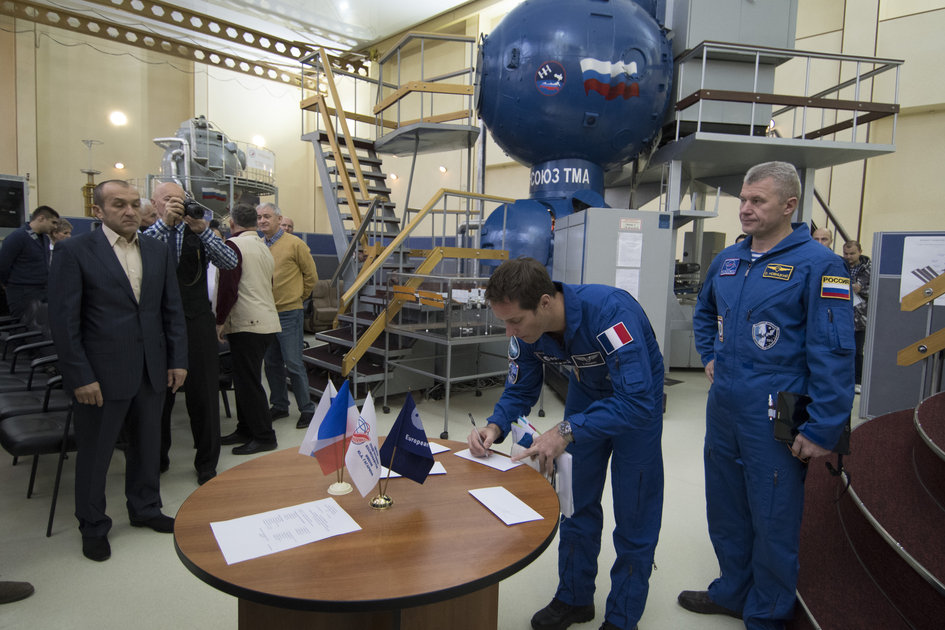.
12.11.2015

ESA astronaut Thomas Pesquet (FR) is assigned to fly on the Soyuz MS-03 spacecraft to the International Space Station, scheduled for launch in November 2016. His crew mates will be cosmonaut Oleg Novitsky of Roscosmos and Peggy Whitson of NASA.
His mission is called 'proxima'. Thomas will be the 10th astronaut from France to head into space and his mission name continues the French astronaut tradition of referring to stars and constellations. The name was chosen from over 1300 entries to ESA’s competition earlier this year.
The winning name was provided by 13-year-old Samuel Planas from Toulouse, France. “Proxima is the closest star to our Sun and is the most logical first destination for a voyage beyond our Solar System,” explains Samuel. “Proxima also refers to how human spaceflight is close to people on Earth.” The logo continues the exploration theme, with star trails evoking future space travel and exploration beyond low-Earth orbit. Two stylised planets can represent our Earth and Moon or the Moon and Mars.
The ‘x’ in Proxima is centred in the middle of the patch to signify the star Proxima Centauri. It also refers to the unknown, as well as Thomas being the tenth French space voyager. The three coloured vertical lines form an outline of the International Space Station and also represent Earth, the Moon and Mars, as well as hinting at the French national flag.
The patch was designed by Thomas Pesquet and Karen Oldenburg.
-
Today, ESA astronaut Thomas Pesquet revealed the name and logo for his six-month mission to the International Space Station starting next November.
Thomas will be the 10th astronaut from France to head into space and his mission name of Proxima continues the French tradition of referring to stars and constellations.
The name was chosen from over 1300 entries to ESA’s competition earlier this year. The winner was provided by 13 year-old Samuel Planas from Toulouse, France.
“Proxima is the closest star to our Sun and is the most logical first destination for a voyage beyond our Solar System,” explained Samuel. “Proxima also refers to how human spaceflight is close to people on Earth.”
The announcement was made in France’s ministry for higher education and research in Paris, in the presence of secretary of state Thierry Mandon, ESA Director General Johann-Dietrich Woerner, and the president of France’s CNES space agency, Jean-Yves Le Gall.
The logo continues the exploration theme, with star trails evoking future space travel and exploration beyond low-Earth orbit. Two stylised planets can represent our Earth and Moon or the Moon and Mars.
.

From left: ESA astronaut Thomas Pesquet, ESA Director General Johann-Dietrich Woerner and French Secretary of State for Higher Education and Research Thierry Mandon at the unveiling of Thomas's mission name and logo.
Thomas will be the 10th astronaut from France to head into space and his mission name of Proxima continues the French tradition of referring to stars and constellations.
The announcement was made in France’s ministry for higher education and research in Paris, in the presence of secretary of state Thierry Mandon, ESA Director General Johann-Dietrich Woerner, and the president of France’s CNES space agency, Jean-Yves Le Gall.
.
The ‘x’ in Proxima is centred in the middle of the patch to signify the star Proxima Centauri. It also refers to the unknown as well as Thomas being the 10th French space voyager.
The three vertical lines form the distinctive outline of the International Space Station as well as representing the colours of Earth, the Moon and Mars, while hinting at the French national flag. Minister Mandon handed Thomas a French flag during the press conference to carry into space.
Thomas commented: “I am really pleased with this mission name and the logo. It ticks all the boxes I had in mind by continuing the naming tradition for French astronauts and recognising the legacy of human spaceflight so far while also being forward-looking and futuristic.”
Science first
As on all missions, as much time as possible will be spent on science. Thomas already has a full schedule performing experiments plus using technology that will allow doctors on Earth to monitor his vital signs while he works.
With a year to go before launch, Thomas will continue the non-stop training since he was assigned as an ESA astronaut in 2009. Thomas flew to Paris for the announcement from training in Houston, USA, and will now fly to Star City in Russia.
“I invite everyone to follow the adventure on social media. Another reason I chose Proxima was because I want to stay close to Europeans,” said Thomas.
“It highlights how human spaceflight is at the service of our planet through scientific results and exploration, and I want to share the experience and inspire the public.”
-


---


Date: 09-17-15
Location: Bldg 9NW, ISS Mockups
Subject: Expedition 50/51 crew members Peggy Whitson, Thomas Pesquet, and Oleg Novitsky during Depress Scene Generic training
Photographer: James Blair
-

Date: 09-17-15
Location: Bldg 9NW, ISS Mockups
Subject: Expedition 50/51 crew members Peggy Whitson, Thomas Pesquet, and Oleg Novitsky during Depress Scene Generic training
Photographer: James Blair
.

Location: Bldg 9NW, ISS Mockups
Subject: Expedition 50/51 crew members Peggy Whitson, Thomas Pesquet, and Oleg Novitsky during Depress Scene Generic training
Photographer: James Blair
.

Date: 09-17-15
Location: Bldg 9NW, ISS Mockups
Subject: Expedition 50/51 crew members Peggy Whitson, Thomas Pesquet, and Oleg Novitsky during Depress Scene Generic training
Photographer: James Blair
.

PHOTO DATE: 15 September 2015
LOCATION: Bldg. 9NW - SVMTF - ISS Mockup Trainers
SUBJECT: Expedition 50/51 crew members Peggy Whitson, Thomas Pesquet and Oleg Novitsky during Fire Scene Generic training.
PHOTOGRAPHER: Mark Sowa
Quelle: ESA
-
Update: 28.10.2016
.
Launch of Soyuz MS-03 space vehicle to ISS postponed till Nov 17
The Soyuz MS-3 was to take to the ISS Russia’s Oleg Novitsky, European astronaut Thomas Pesquet and NASA’s Peggy Wilson on November 15
7186 Views























































